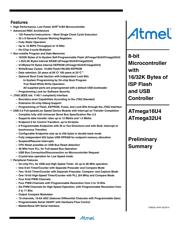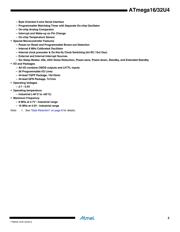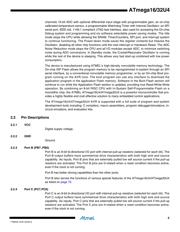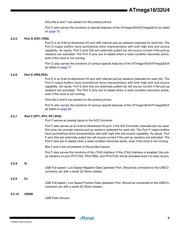Datasheet 搜索 > 微控制器 > ATMEL(爱特美尔) > ATMEGA32U2-AU 数据手册 > ATMEGA32U2-AU 用户编程技术手册 5/24 页
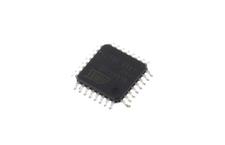
 器件3D模型
器件3D模型¥ 27.209
ATMEGA32U2-AU 用户编程技术手册 - ATMEL(爱特美尔)
制造商:
ATMEL(爱特美尔)
分类:
微控制器
封装:
TQFP-32
描述:
ATMEL ATMEGA32U2-AU 芯片, 8位微控制器, AVR, 32K闪存, USB, 32TQFP
Pictures:
3D模型
符号图
焊盘图
引脚图
产品图
页面导航:
导航目录
ATMEGA32U2-AU数据手册
Page:
of 24 Go
若手册格式错乱,请下载阅览PDF原文件

5
7766GS–AVR–02/2014
ATmega16/32U4
channels 10-bit ADC with optional differential input stage with programmable gain, an on-chip
calibrated temperature sensor, a programmable Watchdog Timer with Internal Oscillator, an SPI
serial port, IEEE std. 1149.1 compliant JTAG test interface, also used for accessing the On-chip
Debug system and programming and six software selectable power saving modes. The Idle
mode stops the CPU while allowing the SRAM, Timer/Counters, SPI port, and interrupt system
to continue functioning. The Power-down mode saves the register contents but freezes the
Oscillator, disabling all other chip functions until the next interrupt or Hardware Reset. The ADC
Noise Reduction mode stops the CPU and all I/O modules except ADC, to minimize switching
noise during ADC conversions. In Standby mode, the Crystal/Resonator Oscillator is running
while the rest of the device is sleeping. This allows very fast start-up combined with low power
consumption.
The device is manufactured using ATMEL’s high-density nonvolatile memory technology. The
On-chip ISP Flash allows the program memory to be reprogrammed in-system through an SPI
serial interface, by a conventional nonvolatile memory programmer, or by an On-chip Boot pro-
gram running on the AVR core. The boot program can use any interface to download the
application program in the application Flash memory. Software in the Boot Flash section will
continue to run while the Application Flash section is updated, providing true Read-While-Write
operation. By combining an 8-bit RISC CPU with In-System Self-Programmable Flash on a
monolithic chip, the ATMEL ATmega16U4/ATmega32U4 is a powerful microcontroller that pro-
vides a highly flexible and cost effective solution to many embedded control applications.
The ATmega16U4/ATmega32U4 AVR is supported with a full suite of program and system
development tools including: C compilers, macro assemblers, program debugger/simulators, in-
circuit emulators, and evaluation kits.
2.2 Pin Descriptions
2.2.1 VCC
Digital supply voltage.
2.2.2 GND
Ground.
2.2.3 Port B (PB7..PB0)
Port B is an 8-bit bi-directional I/O port with internal pull-up resistors (selected for each bit). The
Port B output buffers have symmetrical drive characteristics with both high sink and source
capability. As inputs, Port B pins that are externally pulled low will source current if the pull-up
resistors are activated. The Port B pins are tri-stated when a reset condition becomes active,
even if the clock is not running.
Port B has better driving capabilities than the other ports.
Port B also serves the functions of various special features of the ATmega16U4/ATmega32U4
as listed on page 72.
2.2.4 Port C (PC7,PC6)
Port C is an 8-bit bi-directional I/O port with internal pull-up resistors (selected for each bit). The
Port C output buffers have symmetrical drive characteristics with both high sink and source
capability. As inputs, Port C pins that are externally pulled low will source current if the pull-up
resistors are activated. The Port C pins are tri-stated when a reset condition becomes active,
even if the clock is not running.
器件 Datasheet 文档搜索
AiEMA 数据库涵盖高达 72,405,303 个元件的数据手册,每天更新 5,000 多个 PDF 文件
